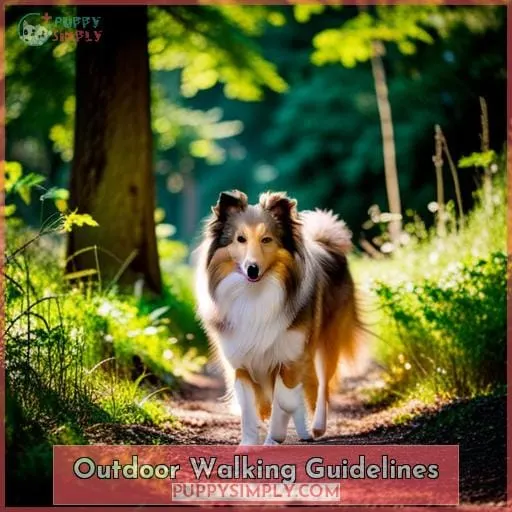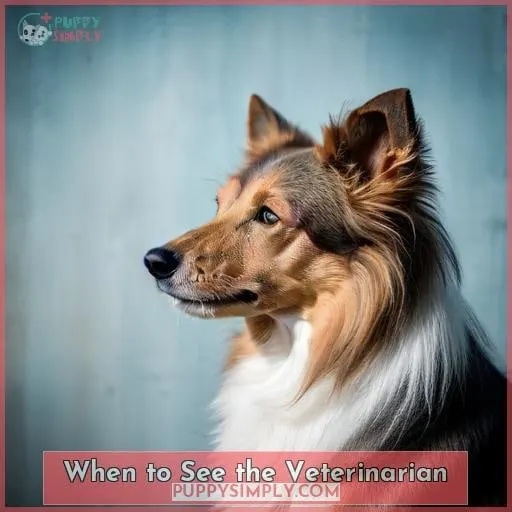This site is supported by our readers. We may earn a commission, at no cost to you, if you purchase through links.

His hip bones seem sharp under thinning fur.
While some visibility is normal in this slender breed, excessive boniness combined with low energy may mean your dog is too skinny.
Monitoring your sheltie’s body condition provides insight on whether weight loss has gone too far.
If worried he’s underweight, examine his eating habits and consult your veterinarian.
Table Of Contents
- Key Takeaways
- Recognizing Signs of Underweight
- Assessing Body Condition
- Monitoring Weight Changes
- Observing Eating Habits
- Outdoor Walking Guidelines
- Sheltie Growth Charts
- When to See the Veterinarian
- Frequently Asked Questions (FAQs)
- What are some recommended treats and snacks for underweight Shelties?
- How can I make mealtimes more appealing and encourage my Sheltie to eat?
- Are there any supplements, vitamins, or other products I should ask my vet about to help put weight on my Sheltie?
- What kind of exercise is safe and appropriate for an underweight or skinny Sheltie?
- What type of dog food (regular, puppy, senior, etc.) is best for helping an underweight Sheltie gain a healthy amount of weight?
- Conclusion
Key Takeaways
- Evaluate body condition using the standard 1-9 body condition score (BCS) system by feeling for ribs, spine, and hip bones and comparing to BCS charts.
- Monitor weight regularly, at least every 1-2 weeks, watching for rapid losses of 10% or more which warrant veterinary assessment.
- Observe eating habits for changes like leaving food uneaten, decreased appetite, and interest in meals.
- Consult a veterinarian for an exam if rapid, concerning weight loss occurs or changes in eating habits are noticed to identify potential underlying medical issues.
Recognizing Signs of Underweight
If your Sheltie’s bones are becoming more pronounced and visible, with ribs, spine, and hip bones easily felt or seen underneath the skin and fur, this indicates potential weight loss.
You may also notice loss of muscle mass and less defined waist and abdominal areas, giving your dog an overly thin or bony appearance instead of a lean, fit look.
These visible signs of weight change warrant closer inspection of your Sheltie’s body condition score and overall health.
Visible Bones
You’ll notice your Sheltie’s spine and hip bones if they’re too thin.
Visible bones can indicate inadequate nutrition or an underlying health issue causing weight loss.
Schedule a veterinary exam to accurately assess your Sheltie’s body condition score.
Address any health problems and consult your vet to develop a nutrition and exercise plan supporting healthy weight gain.
Monitor for improvements with regular weigh-ins and body checks.
Loss of Muscle Mass
Having noticed your Sheltie’s visible bones, you’ll also want to check for signs of muscle loss that can indicate an underweight dog.
Losing muscle mass results in a thin, bony appearance, as the lack of protective fat and muscle tissue causes the skeleton to become more pronounced.
Consult your veterinarian for advice on dietary adjustments or supplements to help address any breed-specific nutritional challenges contributing to muscle loss in your Sheltie.
Monitoring your dog’s energy levels and adjusting exercise routines can also help manage weight loss.
Assessing Body Condition
After recognizing some signs of underweight in your Sheltie, you’ll want to assess its body condition score (BCS) to evaluate if its weight status is ideal.
Use the standard 1-9 BCS system, feeling for your dog’s ribs, spine, and hip bones. Getting an accurate reading can be tricky with a fluffy coat. You may need to wet or blow dry the fur to properly see body contours.
Compare against BCS charts, considering breed characteristics. Make dietary adjustments if needed to achieve ideal weight.
Monitor ongoing trends by periodic BCS checks, weighing your Sheltie, and tracking weight data.
Consult your veterinarian if concerned about rapid weight loss or gain despite attempted interventions. They can exclude illnesses and help customize a nutrition and exercise plan for healthy coat and weight.
Monitoring Weight Changes
Monitoring your dog’s weight is an important way to catch health issues early.
Your fluffy friend won’t always show traditional signs of weight loss like prominent ribs or hips.
Instead, weigh them regularly, at least every 1-2 weeks.
Keep records of their weight overtime in a journal or app.
Rapid weight changes of 10% or more in a short timeframe warrant a call to the vet, even if your pup still looks fluffy.
More gradual losses also deserve investigation.
Alongside weight, note changes in appetite that could indicate discomfort.
Early action lets you get a head start on treatments to get your pup feeling their best again.
Proper nutrition is key for fluffs.
Observing Eating Habits
- You’ll want to pay attention to your dog’s appetite and eating habits.
- Notice if your dog is finishing meals or leaving food uneaten.
- Track changes in your dog’s appetite and interest in food.
- Watch for signs your dog is avoiding hard food or treats due to dental discomfort.
- Be aware if your dog stops begging or showing normal excitement for meals.
Consult your veterinarian promptly about concerning changes in eating that could indicate health issues.
Outdoor Walking Guidelines
Having established your dog’s weight status, let’s consider outdoor walking guidelines for your Sheltie in cold weather.
When taking your Sheltie for walks in cold conditions, be attentive to signs they may need to head back indoors:
- Shivering
- Lifting paws off the frozen ground
- Slowing down
Try to keep walks brief to prevent over-exposure, limiting time outside when temperatures drop below freezing.
Consider your dog’s coat thickness and ability to regulate body temperature before venturing out.
Ensure you have a warm, dry shelter for them to rest in after outdoor exertion.
Monitoring your Sheltie’s comfort level during winter walks is key for responsible weight maintenance and canine fitness.
With some common sense cold weather precautions and attentive leash training, you can maintain an exercise routine beneficial to your dog’s health.
Sheltie Growth Charts
General health and responsible pet ownership are essential for the well-being of both animals and their owners. Regular checkups with a veterinarian can help detect and prevent health issues, ensuring a longer and healthier life for your pet.
Additionally, providing a balanced diet, clean water, and appropriate exercise are crucial for maintaining your pet’s physical and mental health.
Responsible pet ownership also involves providing a safe and comfortable environment, including a clean and spacious living area, proper shelter from the elements, and access to veterinary care when needed.
Regular grooming and parasite control are also important for maintaining your pet’s health and preventing the spread of disease.
By following these responsible pet ownership guidelines, you can help ensure that your pet enjoys a long, healthy, and happy life.
When to See the Veterinarian
If you’re noticing your Sheltie’s unexpectedly dropping pounds or their ribs are poking out too sharply, you’ll want to schedule a vet visit to rule out any medical issues making them underweight.
An abrupt or concerning dip in weight warrants a veterinary consultation to check for parasites, dental disease, cancer, organ dysfunction, and other problems that could cause weight loss.
Even if your Sheltie seems healthy otherwise, unexplained weight changes deserve investigation to ensure no illness is brewing.
Your vet will thoroughly assess your dog’s body condition, weight history, diet, activity level, and additional health parameters.
Based on the evaluation, they can provide tailored nutritional guidance, treat any underlying conditions, and monitor growth patterns over time.
Getting to the root of unexpected weight fluctuations quickly leads to the best outcome.
Frequently Asked Questions (FAQs)
What are some recommended treats and snacks for underweight Shelties?
Offer small, frequent meals of high-calorie, digestible foods like boiled chicken, eggs, or puppy kibble.
Monitor weight changes while increasing intake gradually.
Consult your veterinarian to rule out underlying illness and ensure proper nutrition.
How can I make mealtimes more appealing and encourage my Sheltie to eat?
Hand feed portions of her meals to make eating more interactive.
Warm the food slightly to increase aroma and appeal.
Try moistening dry kibble with low-sodium broths for extra flavor.
Scatter kibble around the room to spark natural foraging instincts.
Switch between wet and dry foods for variety.
Finally, exercise before meals can increase appetite.
The key is finding ways to make eating more enticing.
Are there any supplements, vitamins, or other products I should ask my vet about to help put weight on my Sheltie?
Firstly, ask your vet about adding wet food, healthy oils, or probiotics to boost calories.
But ensure any changes are made under veterinary guidance, as overfeeding risks obesity.
Focus on providing small, frequent nutritious meals in a peaceful environment to stimulate appetite.
Regularly reassessing portions and weight remains key.
What kind of exercise is safe and appropriate for an underweight or skinny Sheltie?
Walks for an underweight Sheltie should start short and easy.
Slowly increase distance as strength grows.
Avoid strenuous hikes or jogging until your vet confirms healthy weight gain.
Focus on gentle, controlled activity tailored to the current fitness level.
What type of dog food (regular, puppy, senior, etc.) is best for helping an underweight Sheltie gain a healthy amount of weight?
Choose a high-quality puppy or adult dog food formulated for your Sheltie’s life stage and activity level.
Prioritize adequate protein and fat content to help increase caloric intake.
Gradually transition to the new food and monitor your dog’s weight gain.
Consult your veterinarian for specific recommendations.
Conclusion
Bottom line, if your sheltie’s hip and rib bones seem increasingly visible despite normal breed slenderness, take a closer look at his body condition, food intake, and energy levels.
Regularly monitoring weight changes and discussing significant losses with your vet helps ensure your pup stays fit as a fiddle.
Keeping an eye out for underweight signs like protruding bones keeps your sheltie from getting too skinny.













